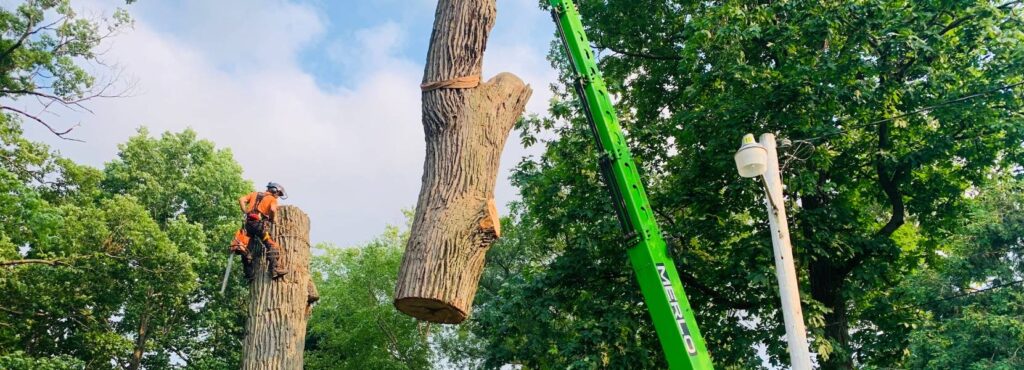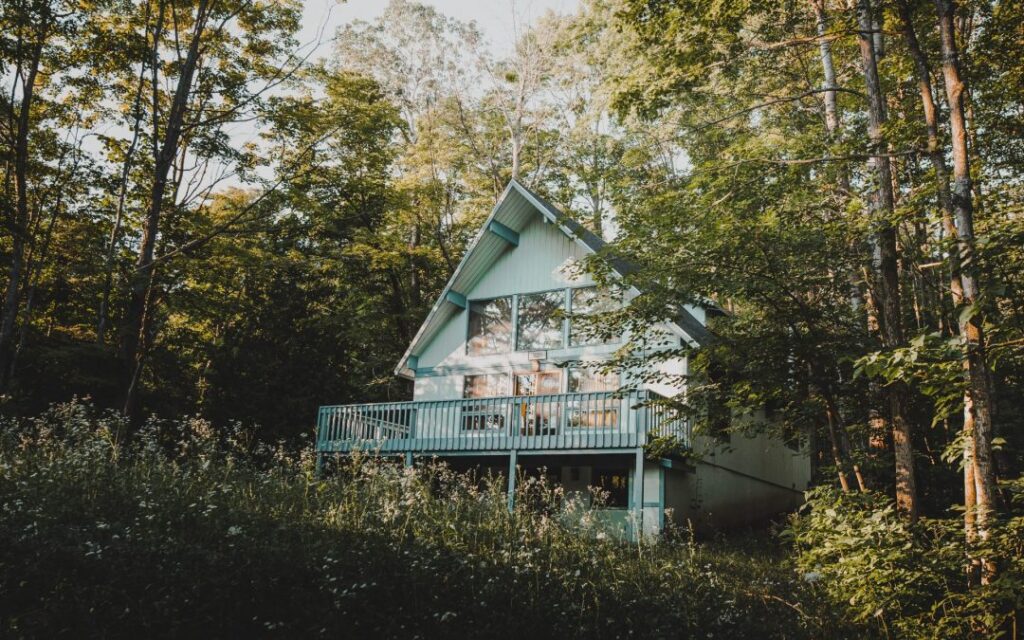5 Common Fungal Tree Diseases in Michiana to Watch Out For
Fungal diseases are common challenges for trees in Michiana. Learn about the symptoms and preventive measures for diseases like oak wilt, anthracnose, and more.
Trees are an excellent addition to any yard in Michiana, as they add property value and reduce cooling costs in the summer. But trees in our area face threats from numerous fungal diseases. Knowing how to recognize the signs of disease is vital to getting them treated and saving them from further harm.
In this article, we will examine five of the most common fungal tree diseases in the Michiana area. We’ll look at the basic symptoms, how fungal diseases spread, and what to do to prevent or treat them.
Key Takeaways
- Oak wilt is a highly infectious and deadly disease that can kill red oaks within a few months; avoid pruning your oak trees during the spring and summer.
- Boxwood blight can defoliate boxwood shrubs and has no cure; prevent the spread of the disease by only purchasing boxwoods from reputable nurseries.
- Thousand cankers disease occurs when walnut twig beetles feed on black walnut trees and spread fungi to the tree.
- Anthracnose is a family of common fungal diseases that damage leaves. Although not usually fatal, it can cause significant damage to dogwood trees.
- This fungal disease spreads most effectively in humid conditions and greenhouses. It mainly causes cosmetic damage, but most plants will recover with appropriate care.
The 5 Most Common Fungal Tree and Shrub Diseases in the Michiana Area
These diseases vary in severity, from causing minor aesthetic damage to potentially killing trees within a few seasons.

This oak tree has been killed by oak wilt. Left photo courtesy of William M. Ciesla, Forest Health Management International, Bugwood.org; Right photo courtesy of Paul A. Mistretta, USDA Forest Service, Bugwood.org, a close up look of oak wilt on the leaves of an oak tree.
1. Oak Wilt
Oaks make lovely shade trees in Michiana but face numerous threats, most concerningly oak wilt. Oak wilt is a fatal disease in the Michiana area. Black and red oaks are most susceptible to contracting the disease and dying, though white oaks are also in danger.
Infected red oak trees can die within two to four months. White oaks may be able to survive an oak wilt infection, or they may decline and die in a few years.
The fungus Bretziella fagacearum causes oak wilt in trees. Once inside, it permeates the vascular system and disrupts water and nutrients freely flowing throughout the tree. If the tree cannot transport nutrients, it will rapidly die.
Oak wilt spreads through two main vectors:
- Sap-feeding beetles: Sap-feeding beetles will carry fungal spores to healthy trees by feeding on the sap from fresh wounds.
- Root grafts. When oak trees grow close together (around 50 feet for most oaks), their roots fuse. These root grafts can spread the fungus from an infected tree to a nearby healthy one. The process continues with any nearby oaks.
Typical symptoms of oak wilt include:
- Visible fungal mats
- Leaves turning dull green or bronze
- Leaves begin to turn yellow and curl around the midrib.
- Leaves fall from the crown (both symptomatic and green leaves)
Treatment and Prevention of Oak Wilt
Currently, there is no cure for oak wilt, making prevention vital. Some prevention methods include:
- Avoid wounding oak trees: Oak wilt spreads when beetles are able to feed on the sap from open wounds. Avoid pruning your oak trees during the spring and summer when oak wilt transmission is at its highest rate. If storm damage or a lawn mower damages the tree, consider applying a wound dressing (we only recommend this for oaks and not other trees).
- Disrupt root grafts: A vibratory plow can break up root grafts and prevent oak wilt from spreading between nearby trees.
- Preventive fungicides: Our understanding of oak wilt is still developing, but you can ask an arborist about preventive fungicides to make your tree more resilient to oak wilt infection.
- Remove infected trees: As soon as you observe signs of oak wilt, contact an ISA Certified Arborist to have them remove the tree and limit further spread of the disease.
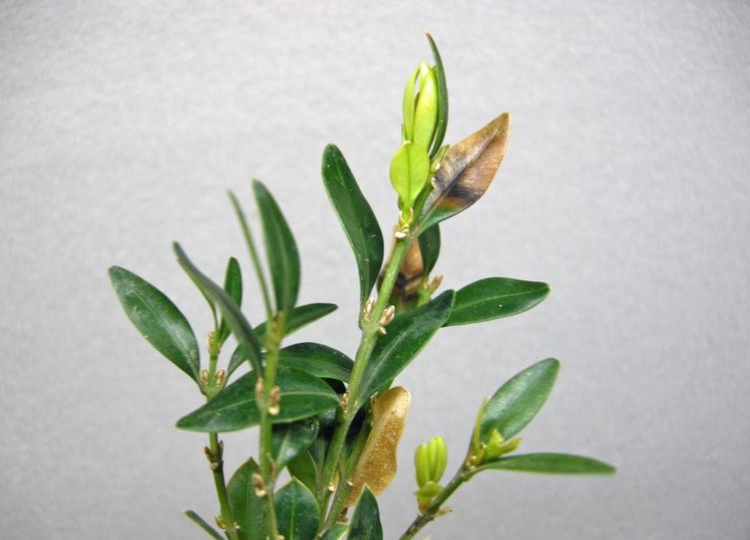
The symptoms of boxwood blight. Photo courtesy of Mary Ann Hansen, Virginia Polytechnic Institute and State University, Bugwood.org.
2. Boxwood Blight
Boxwoods are popular shrubs in Michiana, but they have recently been attacked by the fungal disease boxwood blight. The fungus Calonectria pseudonaviculata causes boxwood blight, commonly spread while the shrubs are in nurseries.
The fungus can infect any part of the boxwood above ground. Symptoms of boxwood blight include:
- Dark leaf spots that form brown blotches
- White sporulation on the undersides of leaves
- A black streak of cankers on green stems (fuzzy white masses will appear when humid)
Boxwood blight can kill young plants and defoliate mature plants, causing them to lose their aesthetic value. If you don’t take action, the defoliation can eventually kill a mature plant.
The fungus overwinters on infected plants and in leaf litter (twigs and leaves that have fallen on the ground). It is spread over short distances through splashing water.
Treatment and Prevention of Boxwood Blight
There is no cure for boxwood blight, and prevention is vital to protect your plants. To prevent the blight from establishing, we recommend preventive fungicides. Apply fungicides when we see cool temperatures and rain in the forecast.
To reduce the spread when boxwood blight is present in the area, we recommend a few techniques, including:
- Only buy boxwood plants from reputable nurseries who check their stock for potential boxwood blight.
- Avoid shearing wet boxwoods to reduce the spread of the fungus.
- Collect any debris and either bag or, if permitted, burn it; do not compost boxwood debris.
- Do not add boxwoods if you have long-established ones.
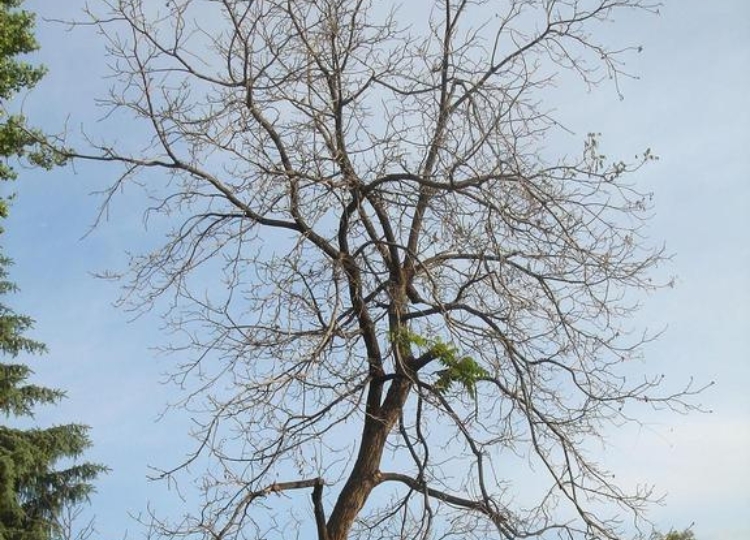
Thousand cankers disease killed this black walnut tree. Photo courtesy of Curtis Utley, CSUE, Bugwood.org.
3. Thousand Cankers Disease
Thousand cankers disease (TCD) is a potentially fatal disease that attacks black walnuts, an essential hardwood in North America. The fungus Geosmithia morbida is responsible for TCD, and the walnut twig beetle spreads the disease to trees.
The beetles will eat the bark on the trunk or branches, causing small cankers to develop. The cankers swell and kill the inner bark of the tree. Eventually, a tree may succumb to the disease when enough cankers appear.
Typical symptoms of TCD include:
- Yellow leaves that become brown and wilted
- Dead branches
- Small cankers on the trunk or branches of trees
- Exit holes from bark beetles
Treatment and Prevention of Thousand Cankers Disease
There is no cure for TCD at this time. The best way to protect your walnut trees from TCD is to reduce tree stress. You can reduce tree stress by:
- Providing supplemental water during a drought
- Fertilizing a tree
- Remove dead or diseased branches through pruning
If you spot TCD, consult an arborist on whether removal is necessary to cut down on the walnut twig beetle population.
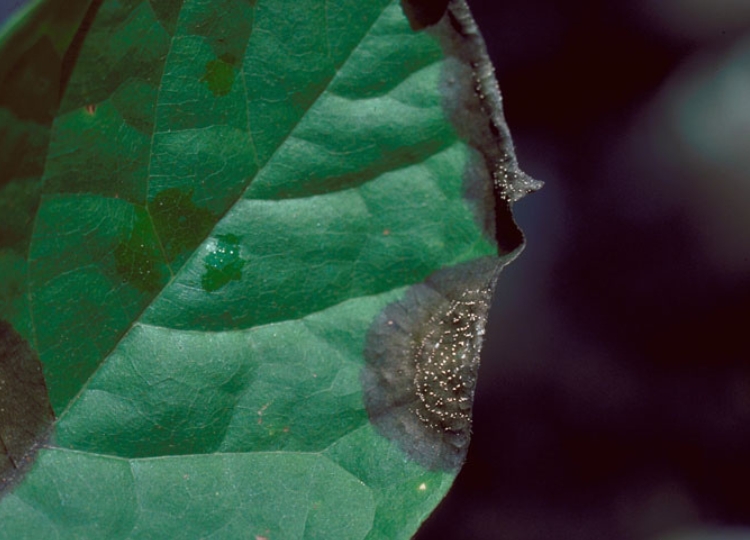
Anthracnose symptoms, photo courtesy of Robert L. Anderson, USDA Forest Service, Bugwood.org.
4. Anthracnose
Anthracnose is a group of related fungal diseases that affect most shade trees in the Michiana area. Anthracnose affects the leaves of a tree, typically starting with leaves on the lower portions of the canopy. Symptoms of anthracnose include:
- Leaves have tan blotches on them
- Leaves are cupped or curled
- Premature leaf drop
- Small blisters on green twigs
Anthracnose is most common in Michiana when we have cool and wet springs. It affects most of our common trees, including ash, oak, maple, and sycamore. Every tree has a different fungus that causes anthracnose, and it can’t spread between different species.
The anthracnose-causing fungus will overwinter in a diseased leaf. Once spring hits, it produces infectious spores that the rain and wind carry to budding leaves.
Treatment and Prevention of Anthracnose
Anthracnose is generally not fatal, and sometimes treatment isn’t needed. Keeping your trees healthy and stress-free is critical to leaving them more resilient to the disease. If you spot anthracnose, hire a professional to prune your tree to remove the dead and dying branches.
Fungicides are generally unneeded, except for dogwood anthracnose, which can be an aggressive form of the disease and potentially kill a tree.
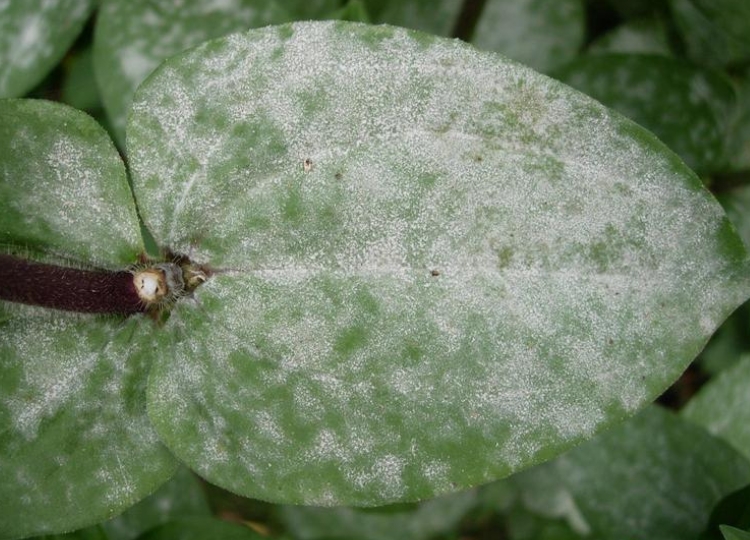
Powdery mildew symptoms, photo courtesy of Elizabeth Bush, Virginia Polytechnic Institute and State University, Bugwood.org
5. Powdery Mildew
Powdery mildew is a common fungal disease in the Michiana area and one of the easiest to recognize. The obvious symptoms are white, talcum-like blotches on leaves. The disease is more common on young leaves and new development rather than established portions of the tree.
Powdery mildew is more common during humid conditions. If you have a greenhouse on your property, you should pay particular attention as the disease thrives in those conditions. We typically see powdery mildew in the spring and fall in Michiana when night temperatures are cool and daytime temperatures are warm.
The powdery mildew fungi create a resting structure to protect spores during the winter before breaking open in the spring and spreading the spores through the wind. Rain and irrigation inhibit the spread of powdery mildew.
Treatment and Prevention of Powdery Mildew
Typically, powdery mildew can be tolerated, as it is not fatal and will mainly harm the plants’ aesthetics.
To reduce powdery mildew spread in future seasons, we recommend planting resistant cultivars of shrubs when doing landscaping work. Pruning a tree’s canopy to increase light penetration and air circulation will also cut down on powdery mildew in trees by reducing the humid conditions in the lower canopy.
Higher Ground Tree Care Can Help You Deal with Common Tree Diseases
Whether your tree is currently dealing with a fungal disease or you want to do preventive maintenance to protect it, fast action is critical to preserving your landscape. Many tree diseases can quickly kill a tree or leave it aesthetically unpleasing.
If you need help with a sick tree, the Higher Ground Tree Care team can help. We’ll diagnose the problem of your tree, suggest a treatment option, and execute the plan to try and save your tree. If the infection is too severe, we can safely and efficiently remove the tree.
Call us today at 574-276-6359 or request a proposal online.


